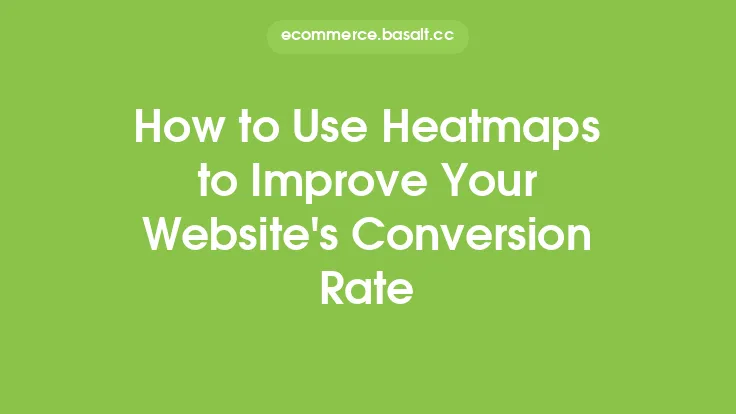Understanding the behavior of your e-commerce website's visitors is crucial for improving conversion rates. Two powerful tools that can help you achieve this are heatmaps and user recordings. These tools provide valuable insights into how users interact with your website, allowing you to identify areas for improvement and make data-driven decisions to optimize your site for better conversions.
What are Heatmaps and User Recordings?
Heatmaps are visual representations of how users interact with your website. They use colors to indicate the areas of your site that receive the most attention, such as clicks, scrolls, and hovers. This information can help you understand what elements on your site are most engaging and which ones are being ignored. User recordings, on the other hand, are recordings of actual user sessions on your website. They show you exactly how users navigate your site, where they click, and how they interact with different elements.
How to Use Heatmaps to Improve Conversion Rates
Heatmaps can be used in several ways to improve conversion rates. Firstly, they can help you identify which elements on your site are most effective at grabbing users' attention. By analyzing heatmap data, you can see which calls-to-action (CTAs) are most clicked, which product images are most viewed, and which sections of your site are most scrolled. This information can help you optimize the placement and design of these elements to maximize their impact. For example, if you find that a particular CTA is receiving a lot of clicks, you can consider making it more prominent or repeating it throughout your site.
How to Use User Recordings to Improve Conversion Rates
User recordings provide a more detailed and nuanced understanding of user behavior than heatmaps. By watching recordings of actual user sessions, you can see exactly how users interact with your site, including any pain points or areas of confusion. This information can help you identify areas for improvement, such as simplifying navigation, improving form usability, or reducing friction in the checkout process. User recordings can also help you understand why users are abandoning their carts or not completing purchases, allowing you to address these issues and improve conversion rates.
Analyzing Heatmap and User Recording Data
To get the most out of heatmap and user recording data, it's essential to analyze it carefully and look for patterns and trends. This can involve segmenting data by user type, device, or location to see how different groups interact with your site. It can also involve looking for correlations between user behavior and conversion rates, such as whether users who watch product videos are more likely to make a purchase. By analyzing this data, you can identify areas for improvement and make targeted changes to your site to optimize conversion rates.
Implementing Changes Based on Heatmap and User Recording Data
Once you've analyzed your heatmap and user recording data, it's time to implement changes to your site. This can involve making design changes, such as moving CTAs above the fold or simplifying navigation menus. It can also involve making functional changes, such as improving form usability or reducing the number of steps in the checkout process. When making changes, it's essential to test and iterate to ensure that the changes are having the desired impact on conversion rates. This can involve running A/B tests or conducting further user research to validate the effectiveness of the changes.
Best Practices for Using Heatmaps and User Recordings
To get the most out of heatmaps and user recordings, there are several best practices to keep in mind. Firstly, it's essential to ensure that you have a large enough sample size to make accurate conclusions about user behavior. This can involve collecting data from thousands of user sessions to ensure that the results are statistically significant. Secondly, it's essential to use heatmaps and user recordings in conjunction with other analytics tools, such as Google Analytics, to get a complete picture of user behavior. Finally, it's essential to test and iterate regularly to ensure that the changes you make to your site are having the desired impact on conversion rates.
Common Challenges and Limitations
While heatmaps and user recordings are powerful tools for improving conversion rates, there are several common challenges and limitations to be aware of. Firstly, heatmaps can be affected by bias, such as users who are more likely to click on certain elements due to their position on the page. User recordings can also be affected by the "observer effect," where users change their behavior because they know they are being recorded. Additionally, heatmaps and user recordings can be time-consuming to analyze and interpret, requiring significant resources and expertise. Finally, heatmaps and user recordings may not provide a complete picture of user behavior, particularly if users are interacting with your site in complex or nuanced ways.
Future Developments and Trends
The use of heatmaps and user recordings is constantly evolving, with new technologies and techniques emerging all the time. One trend is the use of artificial intelligence (AI) and machine learning (ML) to analyze heatmap and user recording data, providing more accurate and detailed insights into user behavior. Another trend is the use of heatmaps and user recordings in conjunction with other tools, such as A/B testing and customer feedback software, to provide a more complete picture of user behavior and optimize conversion rates. As e-commerce continues to evolve, it's likely that heatmaps and user recordings will play an increasingly important role in helping businesses understand and optimize their online presence.





